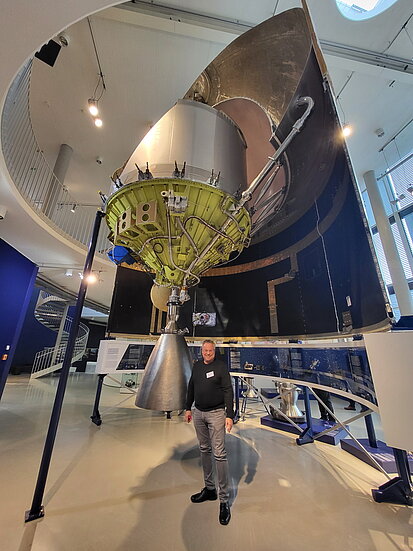Back to the future - real rocket science
![[Translate to English:] Lampoldshausen Stefan Merkle Testzentrum [Translate to English:] Lampoldshausen Stefan Merkle Testzentrum](/fileadmin/_processed_/6/0/csm_Teaserblog_122_Lampoldshausen_e239badb6f.png)
At the beginning of the 1980s, as a student of aerospace engineering at the time, I visited the DLR rocket test stands in Lampoldshausen for the first time during an excursion with Prof. Lo, who was giving the lecture "Chemical Rocket Propulsion" at the time.
I vividly remember how fascinated we were back then as students when we were allowed to watch a test on the P3, as the spectacle was many times louder and more impressive than the rockets I built myself, which only had a propellant charge of around 1 kg and were launched near the edge of the forest at my parents' house in my home village. Probably not entirely legal back then in the 70s, unthinkable today. But I was young and needed the thrill :)
I don't need to mention in this context that my daughter, who is now 24, is called Ariane. How else could I!
Now, some 40 years later, on November 23, 2023 to be precise, at the same location, I once again had the opportunity to attend a rocket engine test, this time on test stand no. 8, as part of a joint network meeting of the HyEcon, HyWaste and Space2Motion networks. I did find out exactly what kind of engine was being tested, but I couldn't remember it and, after all, the blog article has to be finished. In any case, we were standing in a light drizzle after the test bench test, which suggests that it must have been a hydrogen-oxygen engine. Or was it methane?
Several smaller tests during our extensive tour, led by Daniela Lindner from DLR, rounded off the experience of the network partners. In some cases, we only heard the tests acoustically and in others we could hear the fog rising between the treetops. We were also impressed by a visit to the test bench control room, where we were told that it is strictly forbidden to touch a button. I've felt itchy ever since I was born when someone tells me that something is forbidden... somehow it doesn't get any better with age. I seem to have passed this trait on to my daughter at least. On the other hand, I now find it harder to remember things, like the name of the engine of test rig no. 8.
Finally, at test stand no. 5, we were able to admire the Vinci engine of Ariane 6, including the partially assembled upper stage, but not during the test. If I have understood correctly, this will probably run for the last time in December 23 or January 24.
Unfortunately, I can't show you my own pictures, as photography is strictly forbidden outside the museum...
Interesting presentations from all three networks on the unifying topic of hydrogen rounded off the exciting and impressive day. Many thanks also to EURA and the network managers of the three networks for the successful event.
Merkle CAE Solutions supports the project partners in the networks with FEM and CFD simulations. We have many years of relevant experience in the calculation of hydrogen:
- Hydrogen explosions, e.g. in fire chambers, electrolyzers, hydrogen leaks
- for the filling simulation of tanks
- during the icing of H2 lines
- Thermal shock in pipes and nozzles
- Nozzle cooling of rocket nozzles
- Fuel cells with consideration of electrochemistry etc.,
to name just a few of the topics handled by Merkle CAE Solutions.

To give you an impression of Lampoldshausen, I have linked a video showing the site and the tests, as well as pictures from the museum.
Yours Stefan Merkle

PS:
If you would like to find out more about the individual networks, here are the links:
Merkle CAE is a network partner of space2motion and HyEcon.